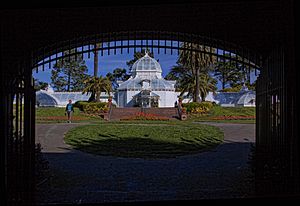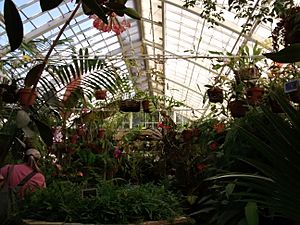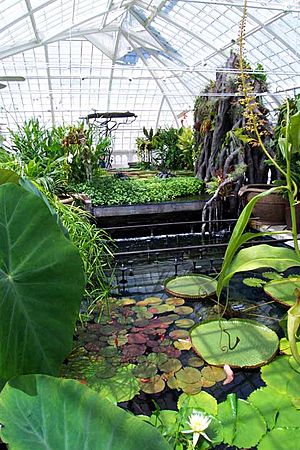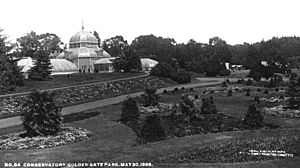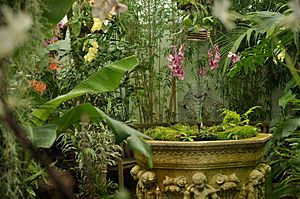Conservatory of Flowers facts for kids
|
Golden Gate Park Conservatory
|
|
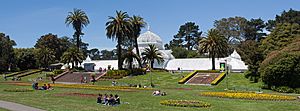 |
|
| Location | San Francisco, California |
|---|---|
| Built | 1878 |
| Architect | Lord & Burnham |
| Architectural style | Italianate, Gothic |
| NRHP reference No. | 71000184 |
Quick facts for kids Significant dates |
|
| Added to NRHP | October 14, 1971 |
The Conservatory of Flowers is a special greenhouse and botanical garden in Golden Gate Park, San Francisco, California. It's filled with amazing and rare plants from all over the world.
This building was finished in 1879, making it the oldest building in Golden Gate Park. It was also one of the first public greenhouses built in the United States. It's the oldest wooden public greenhouse still standing in the country. Because of its history, design, and how it was built, it's listed on the National Register of Historic Places and the California Register of Historical Places. It's also a California Historical Landmark and a San Francisco Designated Landmark.
Contents
What Does the Conservatory Look Like?
The Conservatory of Flowers is a beautiful Victorian-style greenhouse. It has a tall central dome that reaches almost 60 feet (18 meters) high. Long, arch-shaped sections stretch out from the dome, making the building about 240 feet (73 meters) long in total. It sits on a small hill, looking over a valley.
The building is made mostly of wood with glass walls. It sits on a stone base. The whole building looks a bit like a shallow "E" shape. You enter through a glass entryway on the south side. On either side of the main dome are one-story wings shaped like an "L". These wings have small decorative towers on top.
The main dome area is shaped like an octagon. Its arched roof has a special upper section with windows, topped by another dome. The glass panels overlap like roof shingles, following the curve of the arches.
The way the wooden arches were built was very clever. It used small pieces of wood, which made them strong and easy to build. This design also used less wood and made it easier to transport the parts. The unique way the glass overlaps and the special ventilation system are also important parts of the building's design.
Exploring the Rooms Inside
The Conservatory has different rooms, each designed to be like a specific plant environment.
- Potted Plants Gallery: This room shows off many unusual plants in pots and decorative urns. It's kept warm to help these plants grow. This gallery shows how tropical plants were displayed in Victorian times.
- Lowlands Gallery: Here you'll find plants from the tropical lowlands of South America, near the equator. You can see plants that give us bananas, coffee, and cinnamon. This room is usually around 70°F (21°C) and very humid. This is because lowland tropics get a lot of rain, sometimes 100 to 400 inches (250-1000 cm) each year!
- Highlands Gallery: This room has plants from the higher mountains of South and Central America. These plants get their moisture from the air and from water dripping from trees. Because it's like a higher elevation (3,000–10,000 feet or 900-3000 meters), this room is cooler, about 65°F (18°C). It's also very humid, as highland tropics can get 200 inches (500 cm) of rain yearly.
- Aquatics Gallery: This room feels like the areas near the Amazon River. Many carnivorous plants grow here because they love hot, humid places. The soil doesn't have many nutrients, so these plants get what they need by eating insects. The room also has two large ponds, one holding 9,000 gallons (34,000 liters) of water! Both ponds are kept at 83°F (28°C).
A Look at the Conservatory's History
The idea for the Conservatory came from James Lick, a rich businessman who loved science and exotic plants. He bought the parts for the greenhouse, planning to build it in San Jose. But he passed away in 1876 before it was built.
His trustees then sold the kit. A group of important San Franciscans, including Leland Stanford, bought it. They gave it as a gift to the City of San Francisco for Golden Gate Park. The Parks Commission accepted the gift. They hired Lord & Burnham, a company from New York that made greenhouses, to build it. When it opened, it had many rare plants, including a giant water lily that was the only one known in the U.S. at the time.
Why Greenhouses Became Popular
In the 1800s, cities grew bigger, and people wanted more green spaces. Landscape architecture became popular, and designing parks was a big part of it. People also became more interested in studying plants.
This led to the creation of "glasshouses" or conservatories. These were places where city people could see amazing plants that didn't grow naturally in their area. Cities and wealthy people spent a lot of money building these "theaters of nature."
New Building Materials
Early conservatories in Europe, like the Palm House in Kew Gardens in London, became very popular. At first, they were made of wood and glass. But then, engineers like Joseph Paxton started using glass and metal (like iron) for roofs. This allowed for much larger greenhouses, like the famous Crystal Palace built for the first International Exhibition in 1851.
Over time, many builders stopped using wood for large greenhouses. They found that the warm, humid air needed for many plants would often damage the wood quickly.
Wood in California
Even though iron became popular, the Conservatory of Flowers was built with wood. This was because wood, especially redwood, was easy to find in California. Cast-iron greenhouses weren't widely made in America until the 1880s.
Other wooden conservatories existed, but many were destroyed by fire or rebuilt with iron. The Conservatory of Flowers is special because it's one of the few large wooden ones that survived.
Where Did the Conservatory Come From?
Many people thought the building parts were made in England and shipped all the way to California. However, there's no clear proof of this. In fact, studies of the wood show that the main parts were made from Coast Redwood, which grows in California.
This means it's very likely the Conservatory was built right here on the West Coast. Other complex buildings were also being made from redwood in California during the 1870s.
Who Designed It?
No one knows for sure who the exact architect of the Conservatory of Flowers was. Some think it might have been Lord & Burnham, the company that supervised its construction. Others believe it was designed by Samuel Charles Bugbee, a well-known architect of the time. But there are no original documents to confirm either idea.
Lord & Burnham's Role
We do know that Lord & Burnham was hired to build the Conservatory. But it's not clear if they also made all the parts of the building themselves.
Building the Conservatory
The Conservatory of Flowers was a gift from James Lick, even though he didn't live to see it built. It cost about $30,000 to build, which was a lot of money back then!
Construction Facts
The conservatory has an amazing 16,800 window panes! The upper dome alone weighs 14.5 tons.
An old directory from 1879 said: "The whole building required in its construction twenty-six thousand square feet of glass weighing twenty-five tons, and two tones of putty. It is a marvel of architectural beauty, surpassing in this respect any similar construction in the United States."
Repairs Over the Years
The Conservatory of Flowers has needed many repairs over its long life.
The 1883 Fire
In January 1883, a fire broke out, badly damaging the main dome. It's thought the fire started from the furnace. Charles Crocker donated $10,000 to help fix it. The new dome was rebuilt differently, looking more rounded than the original. The eagle statue on top was also replaced with a traditional wooden finial. This was the biggest change to the building's shape ever.
Later 1800s and Early 1900s
The building was painted several times in the late 1800s. In 1894, the area around the conservatory was changed for a big international exhibition. New concrete floors were added in 1899 to help drain water and make visits more comfortable.
The famous 1906 San Francisco earthquake and fire didn't cause much damage to the Conservatory itself. However, the surrounding park needed repairs because many people lived there after the disaster. Minor repairs continued in the early 1900s, including another fire in 1918 that damaged the Potting Room.
Tough Times in the 1930s
During the Great Depression, the Conservatory wasn't well maintained. In 1933, it was in such bad shape that the Parks Commission had to close it. Some parts of the building were rotting and in danger of falling down.
After World War II
After the war, the Conservatory got some much-needed attention. It was painted and had its glass replaced in 1946. A new heating system and new pipes were installed. In 1959, some original doors and vents were replaced with concrete panels. This unfortunately affected the building's natural airflow.
Major repairs happened between 1978 and 1981. Workers checked the wood for rot and treated or replaced damaged parts.
Big Repairs in the 2000s
In the winter of 1995-1996, huge storms hit San Francisco. Winds of 100 mph (161 km/h) blew out 30,000 glass panes and shattered the dome! About 15% of the plants were lost because of the cold air and flying glass. The building was covered with tarps and plywood, and heaters were brought in. Some very large or old plants, like a 112-year-old Brazilian philodendron, couldn't be moved. A special greenhouse was built to protect them during the repairs.
The Conservatory was added to the 1996 World Monuments Watch list, which helps protect important historical sites. This led to a big fundraising effort to collect $25 million for the repairs. The construction work lasted from 1999 to 2003. Finally, on September 20, 2003, the beautiful, restored Conservatory reopened to the public!
How They Fixed It
Experts carefully studied the building to see what was wrong. They found that the wood was rotting in places where moisture collected, especially where the original ventilation system had been removed. Also, copper coverings that once protected the arches had been taken off, allowing water to get in.
To fix it, they carefully took the building apart. They saved any good wood and replaced the badly damaged parts with new redwood. The old glass was also saved. Each piece of wood was tested for strength before being put back or replaced. This careful process brought the Conservatory back to its original beauty and strength.
Images for kids
See also
 In Spanish: Conservatory of Flowers para niños
In Spanish: Conservatory of Flowers para niños






